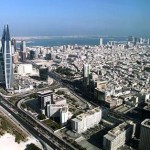
Muscat: Oman could be rewarded for embracing the Paris climate change deal with funding and technical help to tackle the rise in tropical storms and flooding affecting the Sultanate.
Oman has committed to curb its expected Green House Gas (GHG) emissions growth by two per cent in a document sent by the Ministry of Environment and Climate Affairs to the UNFCCC (United Nations Framework Convention on Climate Change) before the landmark climate accord in Paris.
In the ‘Intended Nationally Determined Contribution’ submission, Oman intends to slash its share of green house gases from 90,524 Gg (gigagrams, a unit of measurement equivalent to 1,000 million grams) in 2030 to 88,714 Gg from 2020 -2030 by reducing gas flaring from oil industries and increasing the share of renewable energy besides launching other efforts.
Energy efficiency projects
“Oman will also increase the energy efficiency projects among industries, develop new legislation on climate change which will support the adoption of low carbon and energy efficiency technologies and reduce HCFC (Hydrochlorofluorocarbons) use in foam and refrigeration sector,” says the climate action report.
Climate change has already affected the country with rising sea temperatures causing tropical cyclones, and any change in the temperatures in the coming years is expected to hit coastal areas badly.
Oman’s coastal areas, almost 400 square km of land, will be flooded in the case of the lowest sea level rise and more than 900 square km for the highest,” according to ‘Initial National Communication under the United Nations Framework Convention on Climate Change’ 2013 report of the environment ministry.
That report named the Al Wusta Governorate most likely to be affected from higher sea level cases as around 280 square km of land can be flooded.
Oman authorities fear the climate change could cause tropical cyclone, storm surge, flash flooding, heat waves, sea level rise, coastal erosion, water scarcity, desertification, reduction in fisheries and impacts on marine environment and agriculture.
Oman plans to target green house gases like carbon dioxide, methane, nitrous oxide, hydrocarbons and perfluorocarbons, according to the report.
Muscat has already launched efforts on checking the green house gas emission; however, the country has sought funds saying “further efforts would be made conditional to the fund, capacity building and transfer of technology which will be provided by the UNFCCC.”
Funds for developing world
Officials at the UNFCCC told Times of Oman (TOO) that developed countries have re-confirmed their pledge to provide $100 billion by 2020 to developing countries including Oman.
“And there is good evidence that these investment flows are indeed building. This public money from developed nations is only part of the story,” Nicholas Nuttall, UNFCCC spokesperson told TOO, in an exclusive interview.
He said over the next 15 years an estimated $90 trillion will be invested in infrastructure world-wide.
“The provisions and direction the Paris Agreement should mean that increasing amounts of that investment – leveraged by public funds from developed countries – will be channelled into cleaner, green infrastructure including renewable energy, sustainable transportation and more efficient building,” he said, adding “This in turn can assist in overcoming poverty, improving the environment and triggering a healthier and more prosperous world.”
The UNFCCC official said the climate change accord marks a “decisive” turning point in combating climate change.
“We now have a pathway that, over time, has the potential to dramatically bend down the emissions curve in order to avoid dangerous climate change and in doing so catalyse a far more sustainable development for billions of people including the peoples of Oman,” Nuttall added.
The Paris accord aims to keep a global temperature rise below 2 degrees Celsius and to drive efforts to limit the temperature rise to 1.5 degrees Celsius above per-industrial levels.
Safer defence line
The 1.5 degree Celsius limit is a significantly safer defence line against the worst impacts of a changing climate, according to the UNFCCC officials.
Oman has said that the fund, capacity building and transfer of technology from the UNFCCC are required to make “further efforts” in sustainable buildings, development of renewable energy, energy efficiency, low carbon transport initiatives, low carbon technologies among the industries, methane recovery from solid waste dumping sites and carbon sinks.
Mohammed bin Salim Al Toobi, Minister of Environment and Climate Affairs, Head of the Sultanate’s delegation to the conference, said on Tuesday in his speech at the climate conference in Paris that Oman hopes to complete in 2017 its national strategy to adapt to and mitigate the effects of climate change.
He was representing the Sultanate at the 21st session of the Conference of the Parties (COP) and the 11th session of the Conference of the Parties serving as the meeting of the Parties to the Kyoto Protocol (CMP).
He said that the Sultanate will continue to shoulder its responsibilities in this regard on account of its belief in the principle of a common future and continue to work with the international community.
Suaad Al Harthi, Programme Director, Environment Society of Oman, said some of the most visible impacts of climate change that Oman has faced in recent years has been the increasing frequency of tropical cyclone.


